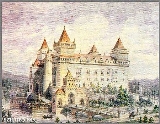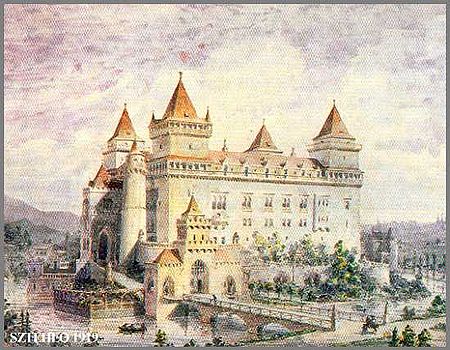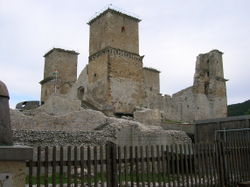
Castle of Diósgyor
Encyclopedia


Diósgyor
Diósgyőr is a historical town in Hungary, today it is a part of Miskolc. The medieval castle in Diósgyőr was a favourite holiday residence of Hungarian kings and queens; today it is a popular tourist attraction. The city part has a heavy industrial background...
which is now part of the Northern Hungarian
Hungary
Hungary , officially the Republic of Hungary , is a landlocked country in Central Europe. It is situated in the Carpathian Basin and is bordered by Slovakia to the north, Ukraine and Romania to the east, Serbia and Croatia to the south, Slovenia to the southwest and Austria to the west. The...
city Miskolc
Miskolc
Miskolc is a city in northeastern Hungary, mainly with heavy industrial background. With a population close to 170,000 Miskolc is the fourth largest city of Hungary It is also the county capital of Borsod-Abaúj-Zemplén and the regional centre of Northern Hungary.- Geography :Miskolc is located...
.
History
The first castle was built in the 12th century, it is likely that it was an earthwork castle and was destroyed during the Mongol invasionBatu Khan
Batu Khan was a Mongol ruler and founder of the Ulus of Jochi , the sub-khanate of the Mongol Empire. Batu was a son of Jochi and grandson of Genghis Khan. His ulus was the chief state of the Golden Horde , which ruled Rus and the Caucasus for around 250 years, after also destroying the armies...
(1241–1242.) The castle that stands today was probably built by King Béla IV, who, after the Mongols left the country, ordered a castle to be built on every hilltop. In the earliest times the castle was an oval structure with a rounded donjon, surrounded by a polygonal outer wall. In 1316 it was mentioned as "new castle", which confirms the theory that it was built in place of a destroyed castle. Judging from a document listing the taxes paid by towns in 1330 it seems the town around the castle was one of the richest towns of the county.
castle had its prime during the reign of Louis I (Louis the Great). Its importance lay in standing near the road leading to Poland
Poland
Poland , officially the Republic of Poland , is a country in Central Europe bordered by Germany to the west; the Czech Republic and Slovakia to the south; Ukraine, Belarus and Lithuania to the east; and the Baltic Sea and Kaliningrad Oblast, a Russian exclave, to the north...
(the mother of Louis the Great, Elizabeth Lokietkówna, was a Polish princess; Louis himself became King of Poland in 1370.) The king had the castle rebuilt and modernised. Surrounded by several walls, the inner castle was built around a rectangular courtyard, and it had four towers, one on each corner. On the first floor were the storerooms and on the second floor were the rooms and the Knights' Hall, which was 25 meters long and 13 meters wide. The modernising of the castle was finished under the reign of Louis' daughter Mary
Mary of Hungary
Mary of Anjou was queen regnant of Hungary from 1382 until her death in 1395.-Childhood:...
. The castle was surrounded by a 4 metre deep moat
Moat
A moat is a deep, broad ditch, either dry or filled with water, that surrounds a castle, other building or town, historically to provide it with a preliminary line of defence. In some places moats evolved into more extensive water defences, including natural or artificial lakes, dams and sluices...
.
In 1364 the nearby town Miskolc was annexed to the Diósgyőr estate. In 1381 the Peace Treaty of Turin was signed in the castle of Diósgyőr. In the treaty the Italian town of Venice was compelled to raise the flag of the Anjou dynasty on the St. Mark square every Sunday. In the north-eastern tower of the castle there is a waxworks exhibition showing the wax figures of King Louis and the Venetian envoy.
Diósgyőr lost some of its importance when the personal union
Personal union
A personal union is the combination by which two or more different states have the same monarch while their boundaries, their laws and their interests remain distinct. It should not be confused with a federation which is internationally considered a single state...
between Hungary and Poland ended (Louis shared the two countries between his two daughters Mary and Jadwiga
Jadwiga of Poland
Jadwiga was monarch of Poland from 1384 to her death. Her official title was 'king' rather than 'queen', reflecting that she was a sovereign in her own right and not merely a royal consort. She was a member of the Capetian House of Anjou, the daughter of King Louis I of Hungary and Elizabeth of...
.) For the next few centuries the castle was a holiday residence for queens. The last queen owning the castle was Maria, wife of Louis II. She gave up the castle formally in 1546 (by this time it had been occupied by the ruling prince of Transylvania
Transylvania
Transylvania is a historical region in the central part of Romania. Bounded on the east and south by the Carpathian mountain range, historical Transylvania extended in the west to the Apuseni Mountains; however, the term sometimes encompasses not only Transylvania proper, but also the historical...
.)
When the Ottoman
Ottoman Empire
The Ottoman EmpireIt was usually referred to as the "Ottoman Empire", the "Turkish Empire", the "Ottoman Caliphate" or more commonly "Turkey" by its contemporaries...
army began to occupy the southern territories of Hungary, the castle was fortified. Its owners, the Gyarmati Balassa
Balassa
Balassa is a Hungarian surname and may refer to:* Bálint Balassa, Hungarian poet * Balint Balassi Memorial Sword Award, Hungarian literary award* Béla Balassa, Hungarian economist who gave his name to the Balassa-Samuelson effect...
family turned it into a large fortress, and they had an Italian-style rondelle built to the north-western tower. The slim turrets were replaced by strong bastions. This was the last time the castle was rebuilt; after 1564 the owners changed frequently, and the castle slowly deteriorated. In 1596 the Ottoman army occupied the Castle of Eger
Eger
Eger is the second largest city in Northern Hungary, the county seat of Heves, east of the Mátra Mountains. Eger is best known for its castle, thermal baths, historic buildings , and red and white wines.- Name :...
and defeated the Christian army at Mezőkeresztes. The castle of Diósgyőr fell too; it was built to be a holiday residence and was never intended to be a large fortress that withstands the siege of a foreign army. From this time Diósgyőr was under Ottoman occupation
Ottoman wars in Europe
The wars of the Ottoman Empire in Europe are also sometimes referred to as the Ottoman Wars or as Turkish Wars, particularly in older, European texts.- Rise :...
and the area was ruled by the Pasha of Eger until 1687 when this part of the country was freed from Turkish rule. By this time the castle lost all of its military importance.
The castle today
The restoration of the castle began in 1953. Originally only the parts threatened with collapsing were restored, but in 1960 the archaeological excavation too. In the northeastern tower (in which the King's room used to be) there is an exhibition of the history of the castle and the Pauline monastery, a weapons exhibition and the waxworks showing the signing of the Torino Peace Treaty. The north-western tower functions as a looking-tower, with a view on Diósgyőr and the surrounding hills; on the ground floor there is a small mint where tourists can make commemorative coins with their own hands. The south-eastern tower (where the Queen's rooms were) cannot be visited, it is mainly used as a dressing room for the actors during the Castle Plays. The south-western tower is in ruins. One of the main tourist attractions of the castle is a larger waxworks exhibitionWaxworks museum of the Castle of Diósgyor
The waxworks museum of the Castle of Diósgyőr is a waxworks museum, one of the largest ones in Central Europe. It is situated in the northeastern tower of the Castle of Diósgyőr, in Miskolc-Diósgyőr, Hungary....
in the outer castle. This exhibition is one of the largest waxworks exhibitions of Central Europe
Central Europe
Central Europe or alternatively Middle Europe is a region of the European continent lying between the variously defined areas of Eastern and Western Europe...
and it shows six scenes of everyday life in medieval Diósgyőr.
The Castle Plays are held twice in every year (May and August). Reviving the Middle Ages, the reign of King Louis and events of Hungarian history, tournaments and open air plays are held, and there is a medieval fair next to the castle. An important musical event, the Kaláka
Kaláka
Kaláka is a folk music group formed in Budapest, Hungary on November 26, 1969. The founding members are Dániel Gryllus, Vilmos Gryllus, István Mikó and Balázs Radványi. Later Mikó was replaced by Péter Dabasi who in turn was replaced by Péter Huzella and later by Gábor Becze. Tamás Kobzos Kiss was...
Folk Festival is held on the second weekend of July each year.
Sadly, unlike the castles of Eger and Kőszeg
Koszeg
----Kőszeg is a town in Vas county, Hungary. The town is famous for its historical character.- History :The origins of the only free royal town in the historical garrison county of Vas go back to the third quarter of the 13th century...
, the castle of Diósgyőr is surrounded by concrete buildings instead of a beautiful historical town, but it is still a popular tourist destination, thanks to the castle plays, the museum, the waxworks exhibitions and Mrs. Déry's House, a small museum dedicated to the popular 19th century actress Róza Széppataki Déry, in the house where she lived.
Literary associations

- On the wall of the castle there is a memorial plate commemorating the visit of the famous poet Sándor PetőfiSándor PetofiSándor Petőfi , was a Hungarian poet and liberal revolutionary. He is considered as Hungary's national poet and he was one of the key figures of the Hungarian Revolution of 1848...
to Diósgyőr on July 8, 1847. He wrote his poem Alkony ("Sunset") here.
| Petőfi Sándor: Alkony | Sándor Petőfi: Sunset | |
| Olyan a nap, mint a hervadt rózsa, | The sun bends her head down slowly | |
| Lankadtan bocsátja le fejét; | Like a fading, fragrant rose | |
| Levelei, halvány sugárok, | Her faint beams, her soft golden leaves | |
| Bús mosollyal hullnak róla szét. | Fall down in sad, silent glows. | |
| Néma, csendes a világ körűlem, | The world is silent 'round me, the | |
| Távol szól csak egy kis estharang, | Sweet sound of the evening bell | |
| Távol s szépen, mintha égbül jönne | Seems to come from the sweetest dream | |
| Vagy egy édes álomtól e hang. | Or from where the angels dwell. | |
| Hallgatom mély figyelemmel. Oh ez | I'm listening, and it feels so | |
| Ábrándos hang jólesik nekem. | Good to hear this dreamy sound | |
| Tudj isten, mit érzek, mit nem érzek, | God only knows what do I feel | |
| Tudja isten, hol jár az eszem. | God only knows what's on my mind. | |
- In the museum of the north-eastern tower visitors can see the original of the picture which can be seen on the back of the 200 ForintHungarian forintThe forint is the currency of Hungary. It is divided into 100 fillér, although fillér coins are no longer in circulation. The introduction of the forint on 1 August 1946 was a crucial step of the post-WWII stabilization of the Hungarian economy, and the currency remained relatively stable until...
banknote (in circulation between 1998–15 November 2009). - The spring that was used to fill the moat with water is now used as a water source for a public swimming pool nearby.
External links
- Official site
- Aerial view of the castle
- Pictures of the castle and how it looked like in the Middle Ages
- Aerial photographs of the Castle
- History, pictures, and google map of the Castle

